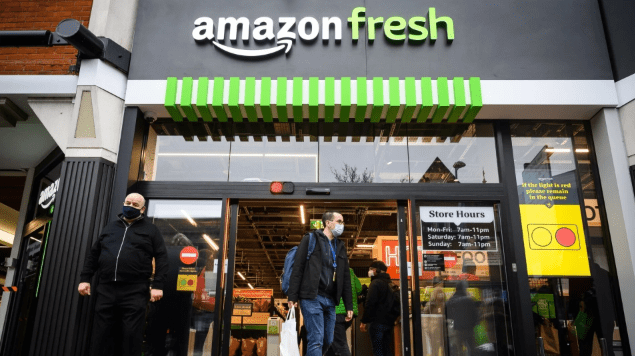In a surprising turn, Amazon has announced the closure of its remaining 19 Amazon Fresh stores in the UK, effectively ending its high-street grocery experiment.
The move comes just two years after the retail giant opened its first checkout-free store in West London, a venture once touted as a bold stride into Britain’s £230 billion grocery sector.
“The very substantial growth opportunities in online delivery” was the reason cited by Amazon for the closures.
Despite its dominance in global e-commerce, Amazon’s foray into Britain’s food retail sector has proven far more challenging than expected.
With the closure of its UK stores, Amazon joins a list of American retail giants who’ve found Britain’s fiercely competitive grocery market difficult to crack.
Amazon’s grand grocery vision in the UK has hit a wall. With all 19 physical stores shutting down, the company is betting big on a digital-first approach just as Britons become more selective about how and where they shop.
Over 260 Stores Planned, Only 19 Opened Now, All Shutting Down
While Amazon never publicly confirmed its target, reports in 2021 suggested ambitions to launch more than 260 Amazon Fresh stores by the end of 2024.
That vision has now been shelved entirely. The very first London store, which opened in 2021 with much fanfare, quietly shuttered in 2023. Now, the last of the Fresh outlets will follow suit.
This doesn’t mean Amazon is exiting the UK grocery space altogether, far from it. In fact, the company is doubling down on what it knows best, online retail.
Shifting Gears: Online Groceries Take Centre Stage
Amazon confirmed it will expand online delivery of fresh groceries and daily essentials via:
- Amazon.co.uk
- Amazon Fresh website
- Partnerships with Morrisons, Co-op, Iceland, and Gopuff
Next year, Amazon will introduce same-day delivery of perishable groceries directly through Amazon.co.uk, mirroring a recently launched U.S. service.
Additionally, five former Amazon Fresh locations will be converted to Whole Foods Market stores, pushing the UK total to 12 by 2026.
Still a Minuscule Slice of the Pie
Despite years in the game, Amazon’s share of the UK grocery market remains under 1%, say analysts. That’s a staggering statistic considering its stock market value is more than 60 times that of Tesco, Britain’s largest supermarket chain.
For perspective:
| Retailer | UK Market Share (%) |
|---|---|
| Tesco | 28.4 |
| Sainsbury’s | 15.1 |
| Aldi + Lidl | 18.9 (combined) |
| Amazon | <1 |
Why It All Went Wrong
Amazon’s struggle appears rooted in a misunderstanding of both British shopping behaviour and the intricacies of UK food retail.
According to former employees and industry experts, the company applied its U.S.-centric, general merchandise model to a market where grocery margins are razor-thin and logistics are highly specialised.
“It’s a volume game, building scale is expensive, and the market is intensely competitive,” said a former UK retail CEO.
German discounters Aldi and Lidl took decades to gain ground in Britain. Online grocery pioneer Ocado is still not reliably profitable, even after 25 years.
And even Walmart, a retail behemoth, gave up on UK ambitions when it sold Asda in 2020.
To make matters worse, Amazon opened its stores during a period of high inflation and squeezed household budgets, pushing tech over value as an approach that failed to resonate with shoppers focused on saving pennies.
Supplier Friction and Regulator Scrutiny
Beyond consumer challenges, Amazon has also found itself at odds with suppliers. Unlike other retailers, it uses automated systems to check inventory, often leading to disputes over missing goods and delayed payments.
“That has led to a disproportionately high number of supplier disagreements,” said David Sables, CEO of Sentinel Management Consultants.
As a result, Amazon has been under investigation by the Groceries Code Adjudicator since 2022 and consistently ranks as the worst-performing UK grocer in terms of code compliance.
The company maintains it is committed to the industry code and aims to improve.
Online Ambitions: A Risky but Familiar Bet
By exiting brick-and-mortar grocery stores, Amazon is returning to its comfort zone: online.
The company cites a PwC Strategy& report predicting that by 2030, over 25% of UK grocery spending will occur online. But scepticism remains.
As of September 2025, online grocery sales made up just 13.4% of the market—down from a pandemic-era high of 15%.
“To reach 25% by 2030 would require something currently unforeseeable to happen,” warned Clive Black, head of consumer research at Shore Capital.
From Disruptor to Footnote?
A decade ago, Amazon’s entry into the UK grocery market had the industry buzzing. Today, it’s barely part of the conversation.
“Now in terms of grocery, Amazon is very rarely mentioned as a serious competitor,” said Black.
Despite the setbacks, Amazon isn’t giving up. But it’s clear that in Britain’s bruising grocery battle, even the biggest names need more than brand power; they need to win the hearts, habits, and baskets of everyday shoppers.






